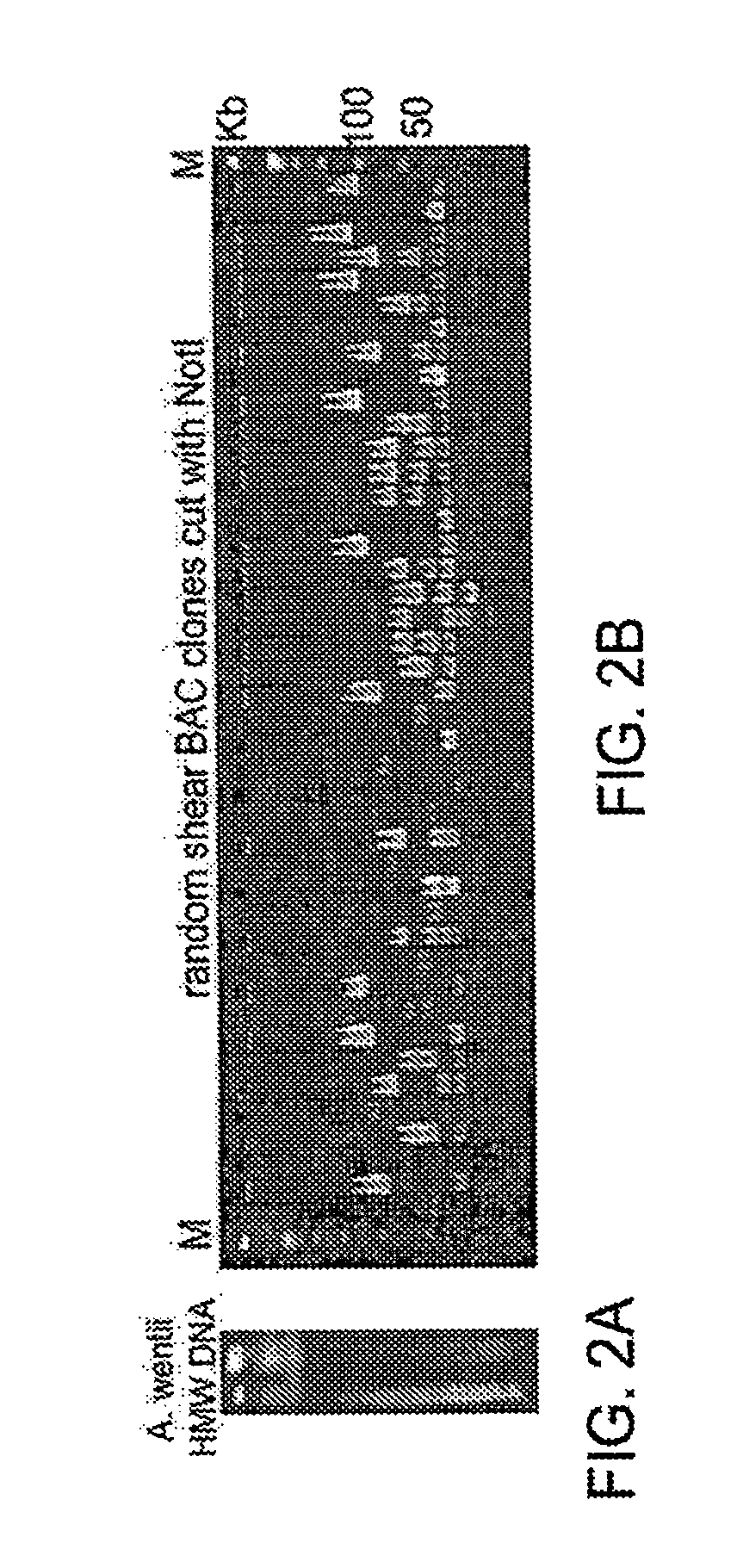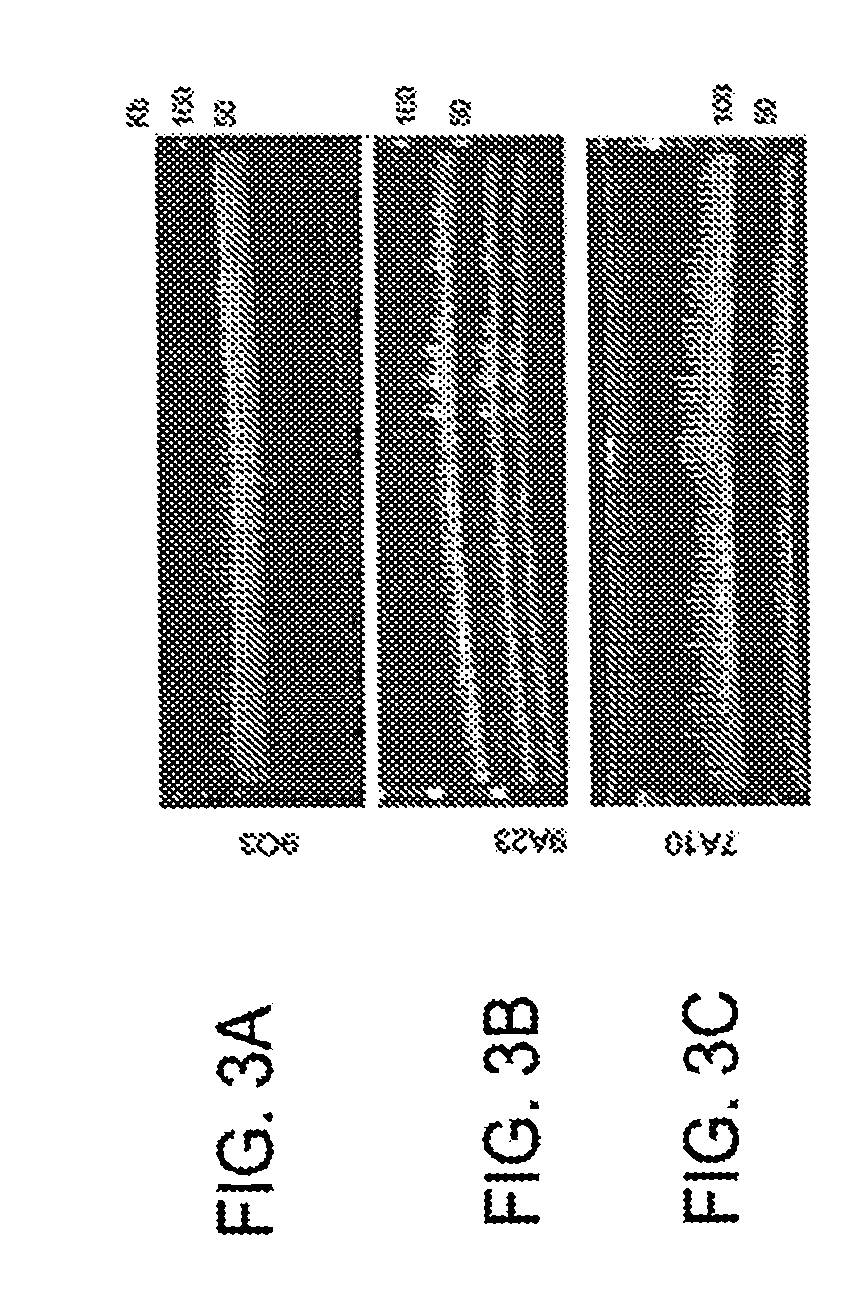Fungal artificial chromosomes, compositions, methods and uses therfor
- Summary
- Abstract
- Description
- Claims
- Application Information
AI Technical Summary
Benefits of technology
Problems solved by technology
Method used
Image
Examples
example 1
[0089]This example describes pFAC plasmid, a vector of the present teachings that maintains extra-chromosomes in A. nidulans.
[0090]In the present teachings, a FAC vector (pFAC, FIG. 1A, SEQ ID NO: 7) is a BAC-based shuttle vector that can shuttle large DNA between E. coli and A. nidulans hosts. Several features are required for maintaining the plasmid in E. coli, including two E. coli origins of replication: oriS and oriV. The first replication origin, oriS, is derived from a low-copy F plasmid for BAC-based large DNA cloning and library construction. The second replication origin, oriV, is an inducible high-copy replication origin oriV, which can produce higher yield of large inserts when grown in E. coli containing a TrfA gene under the control of an arabinose promoter when they are grown on arabinose containing media. pFAC also contains a chloramphenicol-resistance gene (cat) for plasmid selection. For cloning purposes, the plasmid contains a large DNA cloning site comprising pa...
example 2
[0092]This example describes pFACint, a FAC integration vector.
[0093]FAC integration vector (pFACint, FIG. B, SEQ ID NO: 11) is a BAC-based shuttle BAC vector that can shuttle large DNA between E. coli and A. nidulans hosts. Several features are required for maintaining the plasmid in E. coli, including two E. coli origins of replication: oriS and oriV. The first replication origin, oriS, is derived from a low-copy F plasmid for BAC-based large DNA cloning and library construction. The second replication origin, oriV, is an inducible high-copy replication origin oriV, which can produce higher yield of large inserts when grown in E. coli containing a TrfA gene under the control of an arabinose promoter when they are grown on arabinose containing media. pFACint carries kanamycin-resistance gene (kan) as a selection marker gene, or cloning purposes, the plasmid contains a large DNA cloning site comprising pair of BstXI sites designed next to each other in oppose orientations. When dige...
example 3
[0095]This example describes the vector pFACdual.
pFACdual plasmid, which also substantially corresponds pFAC plasmid except that it includes an additional gene cassette: an attP site and a fungal codon-optimized phi31 integrase gene under the control of fungal inducible promoter, such as alcA(p). Therefore, the large DNA pFACdual clones are usually maintaining as FAC and also be able integrated into the fungal genome with an attB site whenever it is needed.
[0096]pFACdual vector is a fungal dual-function vector (pFACdual, FIG. 1C, SEQ ID NO: 14), and can act as both a fungal artificial chromosome and an inducible fungal genomic integration vector, or it can be used as an E. coli-A. nidulans shuttle BAC vector. pFACdual has similar features as pFAC (see Example 1), but pFAC dual has an additional gene cassette: an attP site and a fungal codon-optimized phi31 integrase gene (SEQ II) NO: 16 and SEQ ID NO: 17) under the control of the inducible alcA fungal promoter (alcA(p), SEQ ID NO: 1...
PUM
| Property | Measurement | Unit |
|---|---|---|
| Digital information | aaaaa | aaaaa |
| Digital information | aaaaa | aaaaa |
| Temperature | aaaaa | aaaaa |
Abstract
Description
Claims
Application Information
 Login to View More
Login to View More - R&D
- Intellectual Property
- Life Sciences
- Materials
- Tech Scout
- Unparalleled Data Quality
- Higher Quality Content
- 60% Fewer Hallucinations
Browse by: Latest US Patents, China's latest patents, Technical Efficacy Thesaurus, Application Domain, Technology Topic, Popular Technical Reports.
© 2025 PatSnap. All rights reserved.Legal|Privacy policy|Modern Slavery Act Transparency Statement|Sitemap|About US| Contact US: help@patsnap.com



